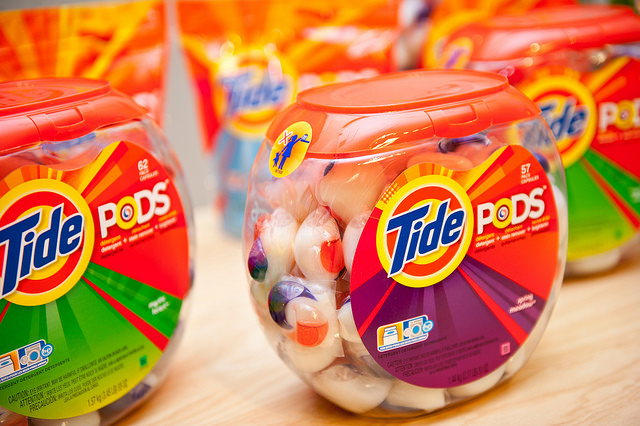Internet culture has always been ridiculous and avant-garde: just look at cryptokitties or “Boaty Mcboatface.” But in 2018, we faced a point of cyber-reckoning when an alarming new trend swept internet communities: the Tide Pod Challenge. Allegedly inspired by a 2015 Onion article, the challenge was simple: eat a tide pod, and see what happens. What did happen? 86 calls to poison control centers in January alone–compared to 53 in all of 2017.
To no one’s surprise, eating a tide pod isn’t as fun as it looks. According to Buzzfeed, completing this challenge can lead to throat irritation, chemical burns in the stomach and esophagus, and acute respiratory distress. If you can find a video of someone attempting the challenge, you’ll see: it doesn’t look good. But finding one of those videos is now near-impossible, because the crisis became so severe that YouTube pulled every Tide Pod video they could find. The poor, beleaguered Tide social media team even released a video, in which Patriots tight end Rob Gronkowski made the message as clear as humanly possible: “NO NO NO NO NO NO.”
The Tide Pod challenge led to innumerable critics throwing shade at Generation Z:

Source: Twitter
But let’s be clear: people have been doing incredibly stupid, potentially lethal things on the internet for years. From the cinnamon challenge to car surfing, we’ve been putting our lives at risk and posting it on the internet since, well, we’ve been able to post things on the internet. Here’s a timeline of some of the very worst ideas that went viral:
The Planking Challenge
Peak: Early 2011
Objective: Hold a plank position in unique (read: stupid and dangerous) locations
Planking started out as an innocent, core-friendly trend. People planked on park benches, on the beach, or in their office. But soon, the internet took it up a notch. The most daring participants planked on moving cars, on trees, in the middle of the road, and any other place where it’s totally inappropriate to lie on your face and lose track of your surroundings. After a smattering of broken bones, and the unfortunate death of a man attempting to plank on a balcony, the trend (fortunately) lost steam.
The Cinnamon Challenge
Peak: Early 2012
Objective: Swallow a spoonful of cinnamon in less than a minute, with no water
This challenge is deceptively innocuous–a spoonful of cinnamon seems far less dangerous than planking on the road. But according to The Washington Post, swallowing dry cinnamon can cause “gagging, vomiting and inhalation of the powder into the lungs.” The Post reported that between January and March 2012, the Poison Control Center received more than 120 calls related to the challenge, and that a few unlucky participants suffered “lung scarring, emphysema, and–in one case–a collapsed lung. Ouch.
The Ghost Pepper Challenge
Peak: Early 2013
Objective: Eat a hot pepper. Film the results, and try not to cry.
This challenge is only for the bravest of the brave–and those with a lot of milk to spare. It tasks participants to pick an extremely hot pepper (ghost, habañero, or the like) and take a big, eager bite. You’re allowed to keep bread, water, or milk by your side to help survive the aftermath–but as the YouTube evidence shows, food doesn’t help much. This challenge usually leaves participants with searing pain and lots of regret. But in particularly severe cases, these peppers have burned through throats, lungs, and esophaguses, and sent five West Virginia children to the hospital. Not as bad as eating a Tide Pod, but still pretty questionable decision making.
Neknomination
Peak: Early 2014
Objective: Drink a high volume of alcohol in a unique way–and challenge your friends to do the same
Although this challenge is lesser-known than some on this list, it’s one of the most deadly. It started out fun–participants took shots in a batman costume, or drank from a toilet bowl (fun is a subjective word). But quickly, it grew dangerous (ex: drinking from a bowl with a dead rat) and lethal–at least five young men died from alcohol poisoning. After widespread panic and outrage, the challenge’s popularity quickly faded.
The Fire Challenge
Peak: Mid 2014
Objective: Pour rubbing alcohol all over your body, and set yourself on fire (this is not a joke)
2014 was a particularly bad year for internet challenges. The fire challenge might actually be worse than the Tide Pod challenge, both in terms of bodily harm and simple objective stupidity. Unsurprisingly, those who attempted this challenge sustained immediate first and second degree burns, requiring more than a few hospitalizations. The internet has since shifted to the safer (but still remarkably dumb) fire spray challenge, in which participants use aerosol cans and lighters to create makeshift flamethrowers. We wouldn’t call it major progress, but at least the fire is no longer aimed at people.
The Car Surfing Challenge
Peak: Mid 2016
Objective: “Surf” on the hood of a moving car
Although car surfing has reportedly been a trend since the 1980’s, the advent of YouTube led to a more recent spike in 2016. This is one of the only challenges that looks like fun to attempt; but unsurprisingly, it’s extremely dangerous: at least seven people died in 2016 alone, and the likelihood of breaking a bone is ludicrously high. We’ll stay inside our cars for now, thanks.
—
These challenges raise a very simple question: why? Newsweek suggested a few reasons: underdeveloped prefrontal cortexes that make it difficult for teenagers to perceive risk, the onset of sensation-seeking behavior during puberty, and the psychological allure of becoming an instant celebrity. It’s possible that and or all of these are correct. But regardless of the biological reason, we need to face a simple truth: it’s not just Generation Z. It’s all of us. We all, no matter how superior we may feel, belong to a generation where someone would eat a tide pod.

Top photo credit: Flickr/ loveat sight
